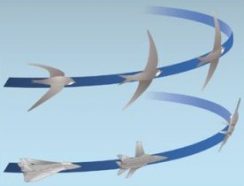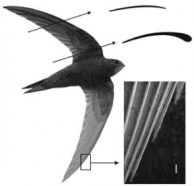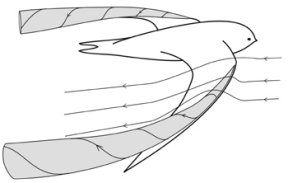Gaining a swift lift
The whirlpools of air that allow insects to fly may also help birds.
Watch a bird soar above the trees or swoop in for a graceful landing. It turns out that the same air movements that allow a mosquito to buzz around your ear or a ladybug to land on your shoulder may also help a bird fly.
 |
|
Birds known as swifts hunt in the air, catching flying insects on the wing. To snag its prey, a swift has to be able to fly fast and make very tight turns, just like a jet fighter.
|
| © Science |
When insects flap their wings, the air above the wings swirls around. Scientists describe these little whirlpools as leading-edge vortices. The result is a pocket of moving air above the wing that has less pressure than the air below the wing. The low-pressure swirls create suction that pulls the bug upward, giving it lift.
Now, scientists in the Netherlands have shown that bird wings can also create such swirls.
Because it’s hard to trace the air moving around a live bird, the scientists made a bird wing of their own. They modeled their wing on that of a common swift, which flies fast and can make tight turns or simply glide.
Birds have two parts to their wings, an arm-wing and a hand-wing. In swifts, the arm-wing is short but the hand-wing is long and cuts into the air with a sharp edge of feathers.
 |
|
When gliding, a common swift shows a torpedo-shaped body. Its arm-wing (close to its body) has a rounded leading edge. The bird’s long, slender hand-wing has a much sharper profile. The inset shows the feathers at the hand-wing’s leading edge.
|
| © Science |
Because air and water flow in similar ways, the researchers put their wing in a water tank. They watched as particles in the water swept over, under, and around the wing. The scientists observed leading-edge vortices above the hand-wing—just like those seen trailing away from insect wings.
 |
|
The sharp leading edges of a swift’s wings may create swirls of air (gray cones) that produce extra lift.
|
| John J. Videler, et al./Science |
Currently, most scientists believe that air flows straight above and below bird wings to lift up the birds, without whirlpools. The new findings should change how people picture bird flight, the Dutch researchers say.
The whirlpools could be what allow swifts and other birds to gain altitude, to stop in mid-flight to catch an insect, or to slow down as they land. The scientists even suggest that the swift’s hand-wing might have developed its special shape just so that it could create these swirls.
However, just because something may be true for swifts doesn’t mean that it’s true for eagles or hummingbirds or pelicans. And the investigators looked only at gliding. They also need to look for swirls above models of flapping wings.
Nonetheless, if bugs do it, birds may very well do it, too.
Going Deeper:
Weiss, Peter. 2004. Swift lift: Birds may get a rise out of swirling air. Science News 166(Dec. 11):373. Available at http://www.sciencenews.org/articles/20041211/fob5.asp .
You can learn more about how insects fly at www.discover.com/issues/apr-00/departments/featphysics/ (Discover) and www.news.cornell.edu/Chronicle/00/3.30.00/insect_flight.html (Cornell University).
Basic ideas about how birds fly can be found at wings.avkids.com/Book/Animals/intermediate/birds-01.html (Cislunar Aerospace).







